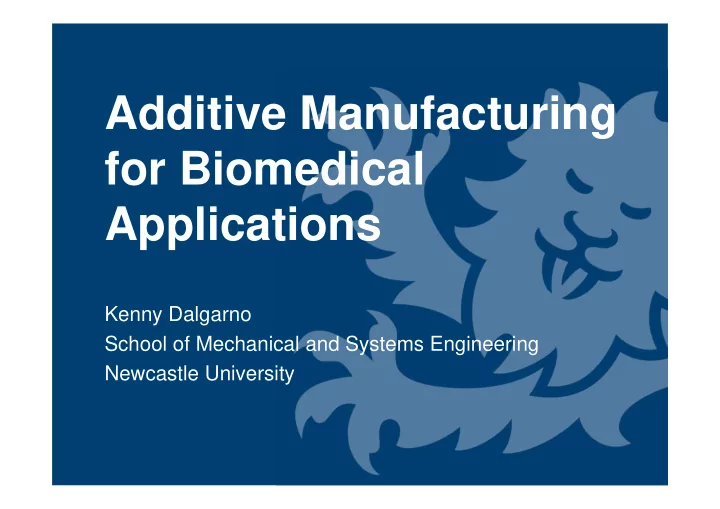

Additive Manufacturing for Biomedical Applications Kenny Dalgarno School of Mechanical and Systems Engineering Newcastle University
Overview Why is additive manufacture interesting for medical applications? A (very brief) history of AM for biomedical applications Future of biomedical AM and AM more generally
Additive Manufacture Machines • High end • Mid-moderate • Low cost $20k – $200k > $200k $1k - $20k
Additive Manufacture Features of additive manufacture: - “rapid” – direct from CAD to machine control, so no significant planning step - Cost is about volume, not geometric complexity Cost models generally favour low volume geometrically complex components Lot size of 1 - Wide range of materials and material combinations possible, but: not many currently “commercial-off-the-shelf” materials not normally “swapable” between machines - Digital supply chain
What does Additive Manufacture enable? Mass Customisation Manufacture at Point of Sale or Use New Material/Structure Combinations All of these are of interest for biomedical applications
Medical Applications First major commercial application was teeth aligners from Invisalign
The InvisAlign Process Automated near net shape manufacture, then material of choice, then a finishing process Semi-automated, CAD driven design process, with geometry capture and scanning to establish initial CAD files Shape, structure and mechanical properties important ~60 million parts shipped to date
In-The-Ear Hearing Aid
Surgical Devices – SimPlant and SurgiGuide from Materialise Bone supported & mucosa supported drill guides www.materialise.com
201 EOS CobaltChrome SP1 Dental Cores
Jaw Reconstruction Implants made in titanium alloy (Ti-6Al-4V)using the ARCAM EBM technology Made by Layerwise in Belgium, implanted in the Netherlands
Personalised AM Designed by Mobelife
Foot and ankle-foot orthoses
Capital Investment and Productivity v’s Traditional Processes
Innovative FOs
Future of AM for Biomedical Applications Mainstream - Lower cost Upstream - Added value For mass healthcare applications this isn’t either/or, it’s both
Future of AM for Biomedical Applications Clinical drivers: lower overall treatment cost and better clinical outcome - minimally invasive - treat problems early To date nearly always hybrid approaches Design automation For mass scale applications scalability within a clinical context and affordability both important
Future possibilities: cell and material co-processing C Barnatt. Organ Printing Concept. www.explainingthefuture.com. 2011.
MeDe Innovation
Future of AM More Generally Also mainstream and upstream Cost and value are key to all industries, not just biomedical A personal view is that we’ll start to see more “product apps” and machines designed for specific applications, as an integrated product delivery system (real “plug and play”)
Questions?
Recommend
More recommend